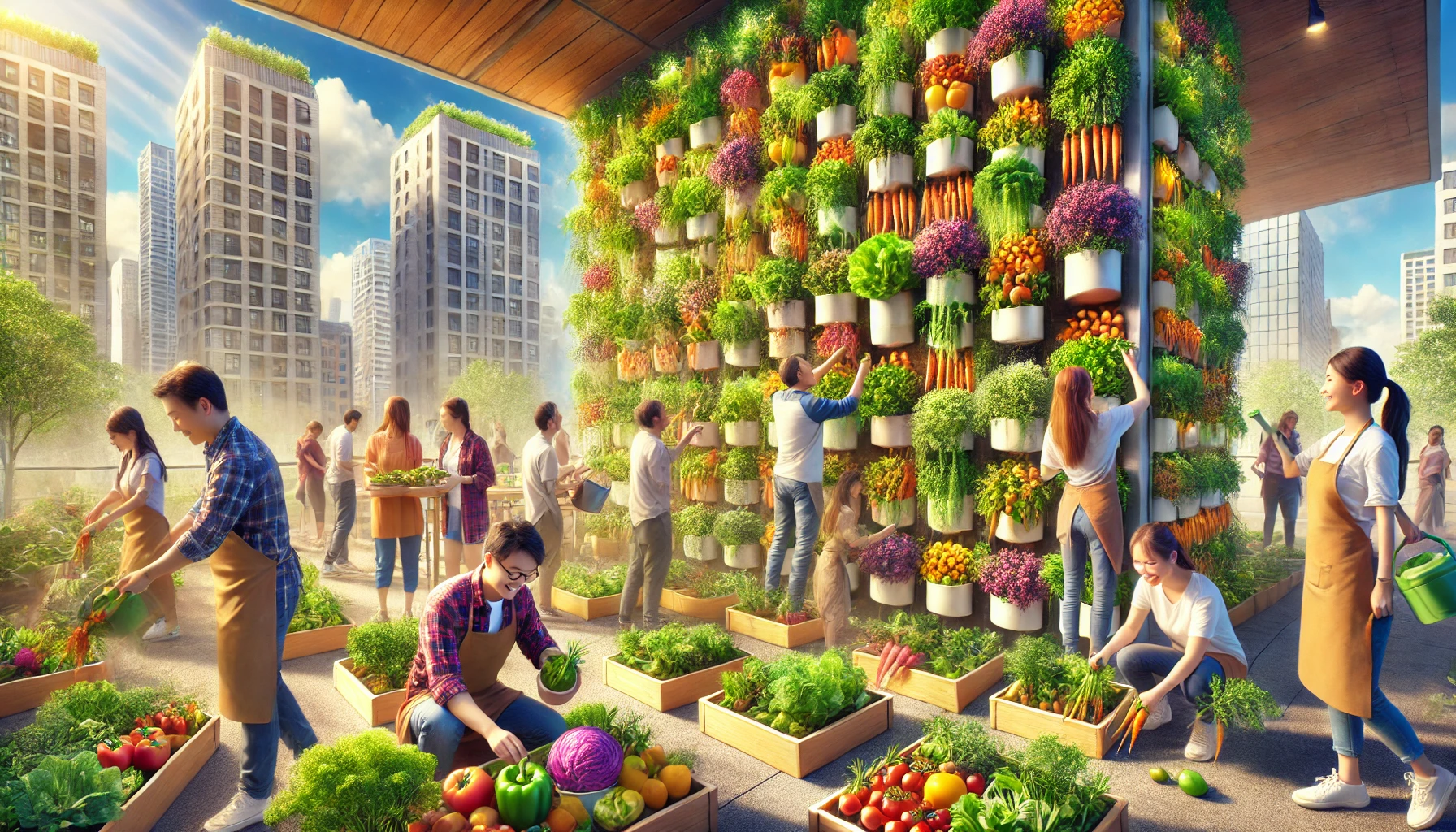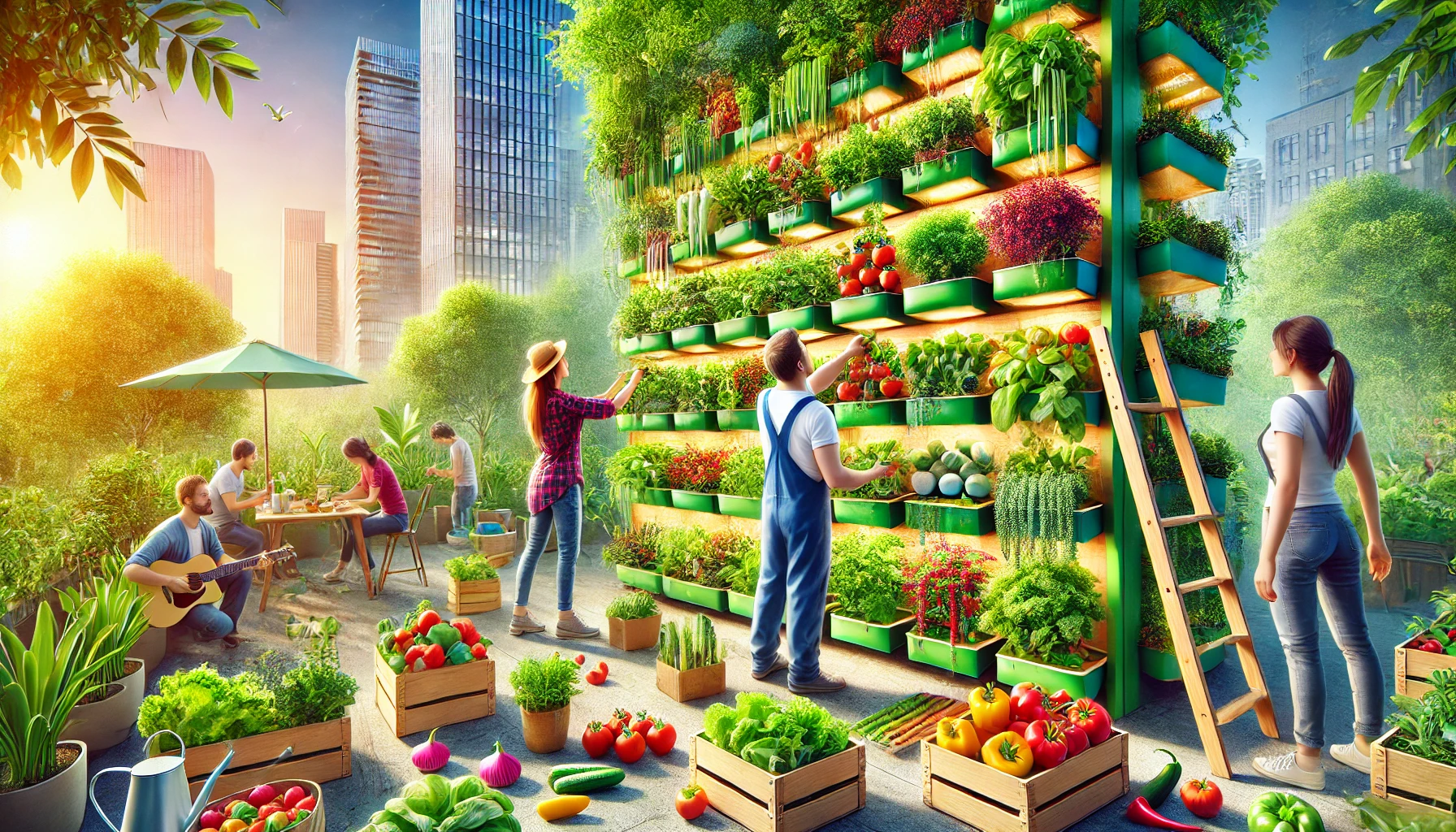In today’s urban landscapes, where outdoor spaces are shrinking, gardeners are finding creative ways to grow fresh vegetables. One of the most exciting trends is vertical gardening—a method that maximizes limited space by growing plants upward rather than outward.
This approach not only saves space but also makes gardening more accessible to those with small yards, patios, or balconies.
Vertical gardening offers a unique opportunity to enjoy homegrown vegetables, even in the heart of the city. Whether you’re a seasoned green thumb or a beginner eager to try something new, vertical gardening can transform your space into a productive and aesthetically pleasing oasis.
This article will help you get started by introducing the best vegetables for vertical gardening and offering practical tips for success.
Best Vegetables for Vertical Gardening: A Quick Start Guide
Why Vertical Gardening Works for Vegetables
Vertical gardening is an efficient way to grow vegetables because it provides better air circulation, reduces pest problems, and makes harvesting easier. Growing upward also helps plants receive adequate sunlight, which is often a challenge in smaller spaces.
By using vertical structures like trellises, hanging pots, and vertical planters, you can significantly increase your yield without needing more ground space.
Top Vegetables for Vertical Gardening
Here are some of the best vegetables to grow in a vertical garden:
- Tomatoes
Tomatoes are a favorite among vertical gardeners. These vining plants thrive when grown with proper support, such as cages or trellises. Vertical growth helps prevent soil-borne diseases and ensures the fruit ripens evenly. - Cucumbers
Cucumbers grow exceptionally well in vertical gardens. Trellising keeps the fruit off the ground, reducing the risk of rot and producing straighter cucumbers. Choose vining varieties for the best results. - Peas
Peas are natural climbers that can quickly cover a trellis or netting. They love cooler weather and reward gardeners with sweet, crisp pods. Trellising also makes picking easier and prevents the pods from rotting on damp soil. - Beans
Pole beans are perfect for vertical gardening, growing tall and yielding a large harvest in a small space. Providing a sturdy trellis or teepee structure ensures the plants remain upright and productive throughout the growing season. - Leafy Greens (Kale, Spinach, Swiss Chard)
While not climbers, leafy greens grow well in vertical wall planters or stacked containers. These greens are easy to harvest and can be grown almost year-round in many climates. - Zucchini and Squash
Zucchini and other summer squash varieties can be grown vertically with a bit of training. Supporting the vines with slings or sturdy trellises prevents the fruit from dragging on the ground.
Climbing to New Heights: Vegetables for Trellises
What is Trellis Gardening?
Trellis gardening is a vertical gardening technique where plants grow upward along a framework of stakes, wire, or lattice.
This method improves plant health, increases yields, and enhances the visual appeal of your garden. Trellises also help reduce the risk of diseases by improving airflow and keeping fruit off the ground.
Best Vegetables for Trellis Setups
- Tomatoes – For indeterminate varieties, trellising helps support heavy fruit loads and promotes healthy growth. Use sturdy cages or weave the stems through a wire trellis for best results.
- Cucumbers – Vining cucumbers flourish on a trellis, producing cleaner and straighter fruits. Netting or wire mesh works well as a support system.
- Pole Beans – These fast-growing plants quickly climb trellises and provide a high yield over the growing season. A-frame or teepee structures work best.
- Peas – Peas naturally cling to trellises with their tendrils. Provide a mesh or netting for easy climbing and abundant harvests.
- Melons and Small Gourds – While heavier fruits like melons need additional support, they can be grown vertically with the help of slings or mesh bags to prevent damage.
Practical Tips for Supporting and Maintaining Trellised Plants
- Choose the Right Trellis: Ensure your trellis is strong enough to support the weight of mature plants and their fruit.
- Use Plant Ties: Soft plant ties or garden twine help secure the plants without damaging their stems.
- Regular Pruning: Prune excess growth to promote air circulation and keep plants manageable.
- Monitor for Pests: Vertical gardening reduces some pest problems, but regular checks are essential to catch any issues early.
Choosing the Right Plants for Vertical Gardens
Vertical gardens are an excellent way to maximize limited space while bringing greenery into your environment.
Whether you have a small apartment balcony or a spacious backyard, vertical gardening allows you to grow a variety of plants without the need for traditional horizontal garden beds.
However, the key to success lies in selecting the right plants. Let’s explore the characteristics of plants that thrive in vertical gardens and highlight some popular options.
Key Characteristics of Plants Thriving in Vertical Gardens
When selecting plants for your vertical garden, focus on varieties that grow well in confined spaces, have shallow root systems, and prefer vertical growth.
These characteristics ensure that your plants will flourish in wall-mounted planters, trellises, or pocket gardens. Here’s what to look for:
- Compact Growth: Plants that don’t require a lot of spreading space.
- Vining or Climbing Habit: Plants that can naturally climb or trail down create a stunning vertical effect.
- Shade or Sun Tolerance: Depending on your garden’s location, choose plants that match the available light conditions.
Non-Vegetable Plants Suitable for Vertical Growth
While herbs and vegetables are popular in vertical gardens, don’t overlook non-vegetable plants that can add color, texture, and fragrance to your space.
- Ferns and Mosses: Ideal for shady areas, these plants bring a lush, green vibe to your vertical garden.
- Succulents: Low-maintenance and perfect for sunny spots, succulents are easy to arrange and offer a striking visual appeal.
- Ornamental Flowers: Petunias, nasturtiums, and trailing lobelia add vibrant color and fragrance to your garden.
- Climbing Plants: Jasmine, clematis, and climbing roses work beautifully on trellises, providing both vertical structure and beauty.
Popular Plant Combinations for Aesthetic Appeal and Productivity
Mixing different plant varieties can create a visually stunning vertical garden while maximizing space efficiency. Here are some tried-and-true combinations:
- Herbs and Edible Flowers: Combine thyme, basil, and marigold for a functional and colorful garden.
- Succulents and Cacti: Create a desert-themed wall with aloe vera, echeveria, and cactus varieties.
- Vining Vegetables with Flowers: Grow cherry tomatoes alongside nasturtiums for a mix of produce and vibrant blooms.
Raising the Bed: Vegetables Perfect for Raised Beds
Raised beds are a fantastic solution for gardeners who want to improve soil quality, reduce weed growth, and manage space efficiently. They offer a controlled environment for growing vegetables, which makes them a popular choice for both beginners and seasoned gardeners.
Advantages of Growing Vegetables in Raised Beds
- Better Soil Drainage and Aeration: Raised beds help prevent waterlogging, ensuring healthy root systems.
- Customizable Soil Mix: You can tailor the soil composition to suit specific vegetable needs.
- Reduced Pest Problems: Elevating plants can deter some ground-dwelling pests.
- Ergonomic Gardening: Raised beds reduce the need to bend over, making gardening easier on your back and knees.
Guide to Selecting Vegetables That Thrive in Raised Beds
Not all vegetables grow equally well in raised beds. Some prefer deeper root space, while others thrive in shallower environments. Here’s a list of top-performing vegetables for raised beds:
- Root Vegetables: Carrots, radishes, and beets grow well in the loose, well-draining soil of raised beds.
- Leafy Greens: Lettuce, spinach, and kale are easy to grow and perfect for continuous harvesting.
- Tomatoes and Peppers: These sun-loving plants do exceptionally well in raised beds with rich, well-drained soil.
- Bush Beans and Peas: Compact and productive, these vegetables are ideal for maximizing yield.

Link Between Raised Beds and Vertical Gardening Efficiency
Combining raised beds with vertical gardening techniques takes efficiency to the next level. For example:
- Trellised Vegetables: Use vertical structures like trellises or cages in raised beds to grow vining crops like cucumbers and pole beans.
- Intercropping Strategies: Plant sprawling crops like zucchini at the base of a trellis to share space with vertical growers.
- Companion Planting: Use vertical space for climbers while filling the bed with companion plants that deter pests and boost growth.
Conclusion: Making the Most of Your Vertical and Raised Gardens
Vertical and raised bed gardening offers endless opportunities for creativity, productivity, and sustainability. By choosing the right plants and combining techniques, you can make the most of your available space while enjoying a bountiful harvest.
Recap of the Best Vegetables for Vertical Setups and Their Benefits
Vertical gardens are perfect for vining crops like tomatoes, cucumbers, and pole beans. These plants save space while producing high yields. Raised beds, on the other hand, are ideal for root vegetables, leafy greens, and bush-type plants. Combining these methods allows you to grow a diverse range of plants in a compact area.
Encouragement to Experiment with Different Setups for Optimal Yield
Don’t be afraid to experiment! Try new plant combinations, rotate crops, and explore different trellis designs. Gardening is a journey of discovery, and the more you learn, the more rewarding it becomes.
Final Tips and Resources for Successful Vertical and Raised Bed Gardening
- Start Small: Begin with a few plants and expand as you gain confidence.
- Monitor and Adjust: Regularly check for pests, water levels, and plant health.
- Leverage Resources: Visit gardening forums, join local groups, and consult guides for specific plant care.
Whether you’re aiming for a lush wall of greenery or a productive vegetable garden, vertical and raised bed gardening offers something for everyone. With a bit of planning and creativity, you can transform even the smallest space into a thriving green oasis.


Vertical gardening is an innovative and space-saving solution for urban gardeners who want to grow fresh vegetables in limited spaces. Herman’s insightful article highlights the best vegetables for vertical gardening and emphasizes how this method improves air circulation, reduces pests, and enhances accessibility. By incorporating trellises, hanging pots, and stacked containers, gardeners can maximize their yields while maintaining an aesthetically pleasing environment.
The recommendations for tomatoes, cucumbers, peas, and pole beans are particularly valuable, as these plants naturally thrive in vertical settings. The inclusion of leafy greens like kale and spinach in wall planters is a great suggestion for those seeking a continuous harvest. Additionally, the tips on trellis gardening and maintaining trellised plants offer practical advice for ensuring healthy growth.For those seeking a continuous harvest, including
Moreover, the article’s discussion of combining vertical gardening with raised beds enhances its usefulness. This strategy allows gardeners to make the most of their available space, effectively integrating climbing plants with ground crops.
Overall, this post serves as a comprehensive guide for both beginners and experienced gardeners, inspiring them to embrace vertical gardening for a productive and sustainable urban garden.
Thank you for the thoughtful feedback! I’m glad you found the article insightful and useful. Vertical gardening truly opens up new possibilities for urban gardeners, and I love showcasing how small spaces can yield big rewards with the right techniques.
It’s great to hear that the suggestions for trellised vegetables and leafy greens resonated with you. Incorporating climbing plants with raised beds is definitely one of the best ways to maximize both functionality and aesthetics. It’s always exciting to help readers create sustainable, productive gardens that bring fresh produce closer to home.
I appreciate you taking the time to share your thoughts. If there’s a specific vertical gardening topic you’d like me to cover next, feel free to let me know!